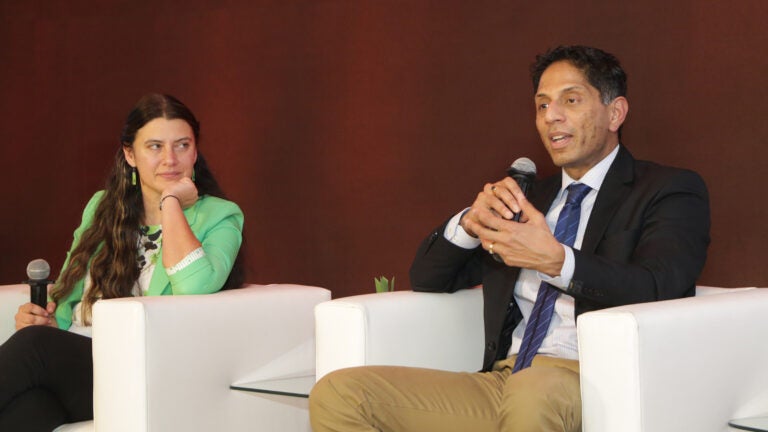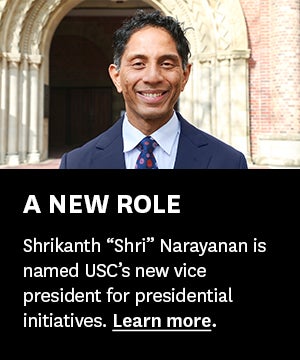
Shri Narayanan, right, shares the stage with USC Viterbi’s Bistra Dilkina during the January visit to India by President Carol Folt and other USC leaders. (Photo/Glamour Photo Video)
Q&A with Shri Narayanan, USC’s new vice president for presidential initiatives
Narayanan, a multidisciplinary scholar with the mind of a scientist and the heart of a musician, sees technology as a powerful force for positive change.
What powers an opera singer’s impressive vocal range? What combination of anatomy and acoustics explains the art and science of human beatboxing? Can we view the hidden workings of the human body that produce these sounds through an MRI? Most importantly, can we leverage this knowledge to improve human health and well-being?
 These are some of the many questions that stir Shrikanth “Shri” Narayanan, USC’s new vice president for presidential initiatives, to action. Narayanan is driven by a profound curiosity about the human experience, and his expertise spans multiple disciplines, including computer science, linguistics and medicine. A University Professor at the USC Viterbi School of Engineering with additional appointments at the USC Dornsife College of Letters, Arts and Sciences and the Keck School of Medicine of USC, he has made groundbreaking contributions to human-centered sensing, computing and information processing.
These are some of the many questions that stir Shrikanth “Shri” Narayanan, USC’s new vice president for presidential initiatives, to action. Narayanan is driven by a profound curiosity about the human experience, and his expertise spans multiple disciplines, including computer science, linguistics and medicine. A University Professor at the USC Viterbi School of Engineering with additional appointments at the USC Dornsife College of Letters, Arts and Sciences and the Keck School of Medicine of USC, he has made groundbreaking contributions to human-centered sensing, computing and information processing.
USC News sat down with Narayanan to discuss his thoughts on how technology, human expression and health intersect, and to understand how his diverse research background has molded his approach to addressing some of society’s most pressing challenges.
If you had to describe yourself “in action” on a typical day, what would that look like? Where would we find you, and what would you be doing?
Narayanan: I like to be on campus by 8 a.m. at the latest. You’ll usually find me in my office, at my standing desk in the corner and with my doors open so people can drop in. But the very first thing I do is turn on my music, which is always playing in the background as I spend the day reading, writing and catching up on email.
I’m a big fan of South Indian classical music and am an amateur musician myself. I enjoy the Indian style of violin playing, as well as the veena, which is an ancient lute-like instrument. You might recognize it as the instrument held by Saraswati, the Hindu goddess of learning and the arts.
Your work bridges multiple disciplines, from computer science to linguistics and medicine. How do you effectively translate and transfer knowledge from one domain to another?
I’ve always been fascinated by what it means to be human, and how we experience the world around us. Starting out as an engineer, I began by studying the physical mechanisms of human functioning through the lens of physiology and behavior. This naturally led me to broaden my focus to include human cognition and emotions.
I love exploring different areas of science, from applying discoveries to real-world problems (like in medicine) to creating innovative technologies. And through it all, I’m always thinking about how these advancements impact society.
What makes the human voice such a compelling subject of study for you?
The human voice is remarkably versatile; we use it for basic communication, expressing emotions from joy to grief, and crafting artistic forms like singing and beatboxing. My research explores the depths of this instrument we are given, delving into its physical mechanics and the fascinating brain processes behind our vocal expressions.
These expressions are shaped by our intentions, cultures and communities, making the human voice a powerful tool for connection and self-expression. There is still much to learn about speech sounds — how they vary across languages, evolve in childhood and change with age.
As scientists, we try to unravel these mysteries and harness this knowledge for creative inspiration and practical applications. For instance, the incredible high notes of sopranos push the boundaries of vocal ability, informing and enriching the art of singing. Beatboxing, a newer art form, imitates mechanical sounds like drums, raising questions about the link between these fascinating sounds, human cognition and language.
Studying these art forms can translate to practical uses, offering insights into diagnostic, therapeutic and rehabilitative applications. We can use this knowledge to help restore essential functions in individuals affected by conditions like cancer, helping them regain not just the joy of singing or speaking, but fundamental functions like swallowing and breathing.
Your work with the Keck School of Medicine spans both otolaryngology — head and neck surgery — and pediatrics. What aspects of children’s health and development inspire your research?
I’m deeply inspired by the potential to make technology truly inclusive, especially for children. Many of the technologies we enjoy today aren’t designed with kids in mind and often fail to meet their needs. Several factors — from physical changes in their bodies to the evolution of their cognitive processes — play a vital role in how they communicate and interact with technology. By harnessing the power of data science and partnering with pediatric researchers and clinicians, we can actively contribute to shaping the development of inclusive technologies like Alexa and Siri.
What truly excites me is the prospect of seeing our efforts translate into tangible solutions that empower children of all backgrounds and abilities. From children on the autism spectrum to those with diverse learning needs, our goal is to create a world where technology not only adapts to their unique trajectories but also celebrates their diversity.
Have you had any unexpected sources of inspiration throughout your career?
I’ve always analyzed human behavior — how people talk, behave and interact — without initially seeing its broader social or scientific implications. Years ago, I connected with Megan Smith, who later became President Obama’s chief technology officer. She was a high-level executive at Google at the time and reached out to discuss her work. Around the same time, the actress Geena Davis was exploring how women are portrayed in the media. We found ourselves analyzing movies, using AI tools like natural language processing and computer vision and found that women were largely underrepresented in terms of speaking time and screen presence.
This sparked a partnership with the Geena Davis Institute on Gender in Media and Google. We extended our analysis to television shows and movie scripts across various languages, including in India. The experience opened up new avenues of research for me. It’s remarkable how unexpected connections can lead to impactful research — even bringing Hollywood actors into my engineering lab meetings, which was quite unusual but very enriching.
What are you most looking forward to about your new role as vice president for presidential initiatives?
It’s truly exciting to see how empowering people and fostering connections can lead to incredible innovation and creativity. Whether it’s working with undergraduate students or seasoned colleagues, I’m continually inspired by the fountain of ideas they bring. This opportunity, presented by President Carol Folt, to support and collaborate with individuals across the university and beyond in tackling big societal questions, and in translating ideas to action and impact, is particularly exciting. It’s these big questions and the collaborative effort required to address them that keep me motivated.



